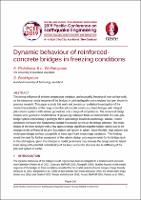| dc.description.abstract | The strong influence of ambient temperature variation, and especially freezing of near-surface soils, on the transverse modal response of the bridges in cold earthquake-prone regions has been shown in previous research. This paper extends this work and presents an analytical investigation of the modal characteristics of the range of reinforced concrete continuous beam bridges with integral pile-column systems with various geometries over a range of temperatures. The numerical bridge models were geometric modifications of previously validated finite element models of a soil–pile-bridge system representing a prototype three-span bridge located in Anchorage, Alaska. Frozen conditions increased the fundamental modal frequencies across all the bridge schemes. The mode shapes of the short bridges with a few spans undergo significant transformation mainly due to the changes in the stiffness of the pier-foundation-soil system in winter. More flexible, high column and multi-span bridges are less susceptible to these significant mode shape variations. The findings reveal the need for further assessment of the seismic design code requirements for the bridge stock in the cold regions, given that changes in modal parameters may increase the design seismic lateral loads along with potential redistribution of the loads across the structure due to stiffening of the pile-soil system in winter. | en_US |

